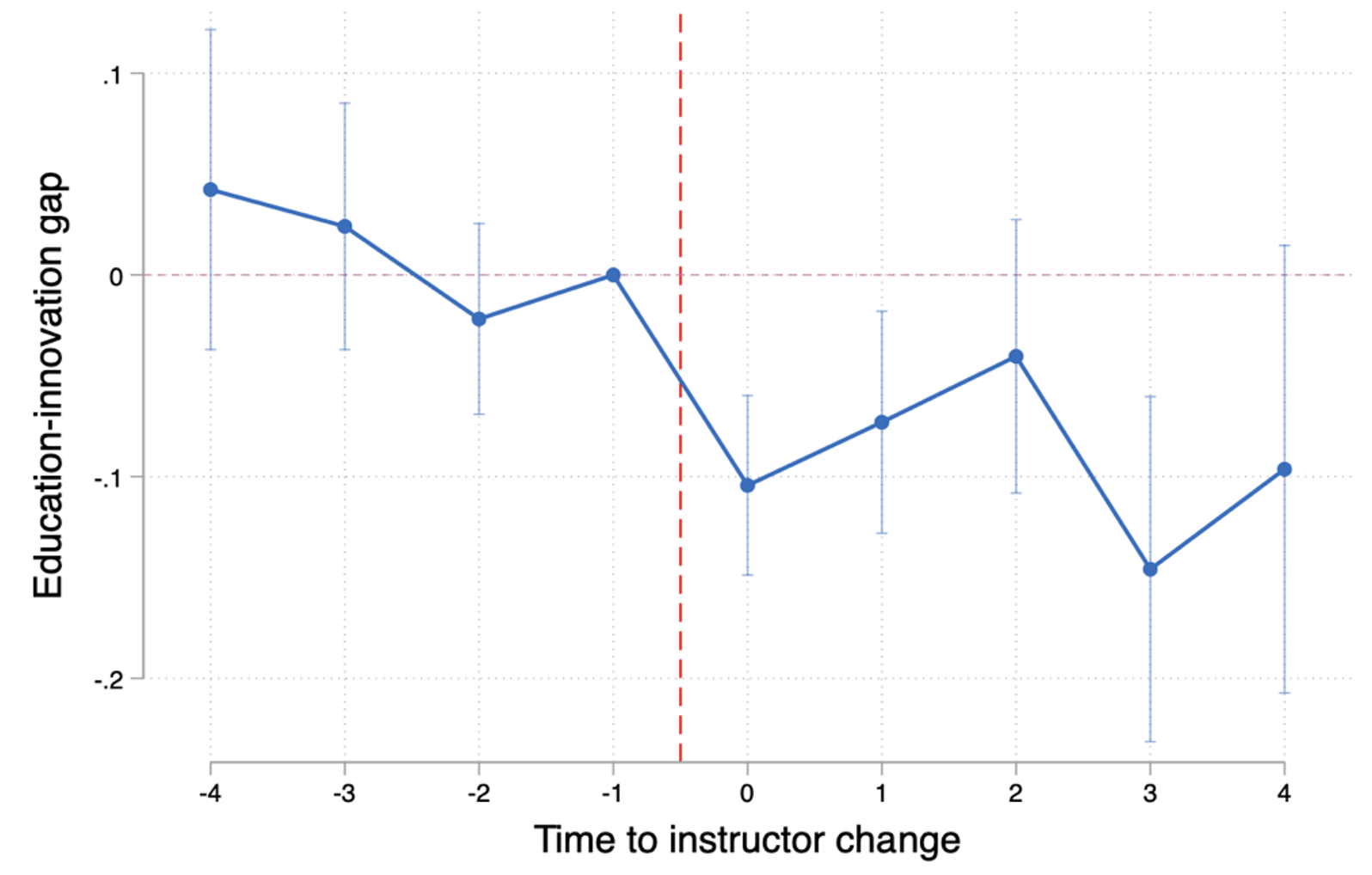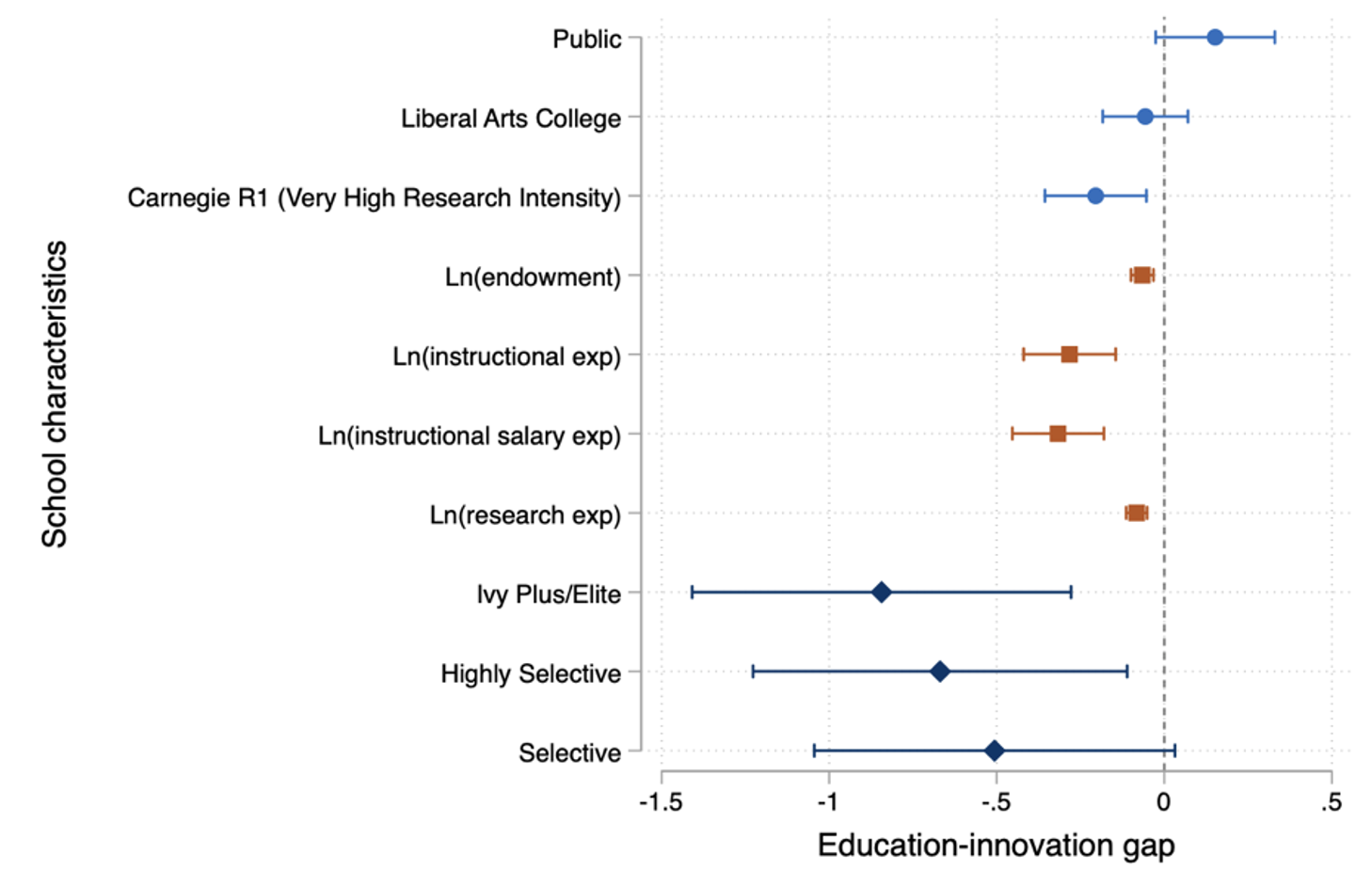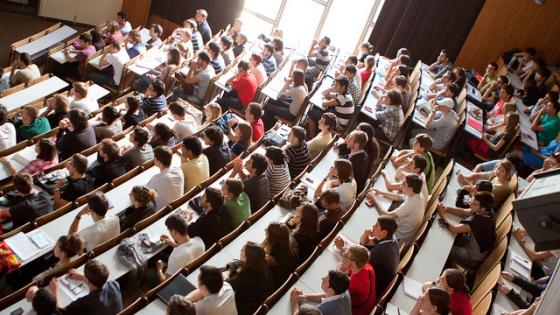Higher education programmes play a central role in the dissemination of up-to-date knowledge, which is essential for innovation and economic growth (Jones 2005, Goldin and Katz 2010, Jones 2009). Through their curricula, higher education programmes facilitate human capital accumulation and nurture future innovators, especially in a world where ideas are becoming harder to find (Bloom et al. 2017). Yet, these programmes have been shown to differ greatly in student outcomes, including earnings (Hoxby 2020, Mountjoy and Hickman 2020) and rates of invention (Bell et al. 2019).
We argue that higher education programmes have different abilities to equip students with up-to-date knowledge. These differences are shaped by traits at the school and instructor levels, and they can have important implications for labour market outcomes, education choices, and technological progress.
Novel data and methods to measure the content of higher education
In Biasi and Ma (2022), we bring together new data and a novel methodology to measure the extent to which higher education courses across US institutions cover frontier – i.e. recently produced – knowledge. Applying modern text analysis techniques to a large sample of course syllabi (capturing the content of courses) and academic publications (capturing the frontier of knowledge), we build a novel metric – the education–innovation gap. The education–innovation gap is designed to capture the distance between education content and the knowledge frontier. Specifically, we define the gap as the ratio of similarities between a course’s content and knowledge from older vintages (covered by articles published decades ago) and between the course’s content and new, frontier knowledge (covered by the most recent articles).
Naturally, the gap is higher for syllabi that cover more knowledge that is older (rather than newer). For example, a computer science course that teaches Visual Basic (a relatively obsolete programming language) in 2020 would have a larger gap than a course that teaches Julia (a more recent programming language), because Visual Basic is mostly covered by old articles and Julia is mostly covered by recent articles.
Examining variations in the education–innovation gap across courses reveals stark differences in the coverage of educational content, both across and within schools. For example, to move a syllabus from the 25th to the 75th percentile of the gap distribution, approximately half of its content would have to be replaced with newer knowledge.
Instructors are crucial in shaping course content
Most of the observed variation in the education-innovation gap (about a quarter) occurs within schools, across courses taught by different instructors. The impact of instructors can also be seen from the fact that the gap of the typical course remains stable over time, but it declines significantly when the instructor of a course changes.
Figure 1 Event study: The education–innovation gap around an instructor change
Notes: Event study of the education-innovation gap around an instructor change, controlling for course and field-by-year fixed effects. Observations are at the course-by-year level; we focus on courses with at most two episodes of instructor changes. Standard errors clustered at the course level.
Most higher education instructors split their time and effort between teaching and research, reflecting the dual mission of universities to produce and disseminate knowledge. As time is scarce, these tasks are often seen as competing (Hattie and Marsh 1996, Courant and Turner 2020). The nature of higher education, though, could also create complementarities between the two (Becker and Kennedy 2005, Arnold 2008).
Our findings support the latter hypothesis: the education–innovation gap is significantly lower for courses taught by instructors who are more active in producing research (i.e. they publish more, are cited more, and receive more grants). The gap is instead higher for non-ladder faculty who specialise in teaching. The gap is also lower when the instructor’s own research is closer to the topics of the course.
These findings highlight that proper deployment of faculty across courses can bring the content of education closer to the knowledge frontier. They also suggest that investments in faculty research – both public (i.e. government grants) and made by each institution – can generate additional returns in the form of more updated instruction.
Significant differences across schools
Schools explain just a small fraction of the total variance in the education-innovation gap. Still, cross-school differences are useful for understanding how the content of higher education is shaped and how the access to frontier knowledge varies across students from different socioeconomic backgrounds. The gap is smaller in schools with a stronger focus on research (ranked as R1 in the Carnegie classification) and with more resources (higher endowment and spending on instruction and research). The gap is also smaller in more selective schools (for example the ‘Ivy Plus’, which includes the eight Ivy League colleges plus Stanford, MIT, Duke, and the University of Chicago) compared to non-selective schools. The magnitude of this difference is such that to make the average syllabus in a non-selective school comparable to the average syllabus in an Ivy Plus school, 8% of its content would have to be replaced with newer knowledge.
Figure 2 The education–innovation gap and school characteristics
Notes: OLS point estimates and 95% confidence intervals of the slope of the relationship between each reported variable and the education-innovation gap controlling for field-by-course level-by-year fixed effects. Each estimate is obtained from a separate regression, except for selectivity tiers (Ivy Plus/Elite, Highly Selective, Selective), which are jointly estimated. Endowment, expenditure, and share minority refer to the year 2018 and are taken from Integrated Postsecondary Education Data System. Estimates are obtained by pooling syllabi data for the years 1998 to 2018. Standard errors are clustered at the school level.
Importantly, differences across schools translate into disparities in access to up-to-date knowledge across students with different backgrounds. The education–innovation gap is significantly higher in schools enrolling students with lower median parental income and those with a higher share of Black or Hispanic students.
In principle, part of these differences could be due to a ‘vertical differentiation’ of educational content across schools. If students with greater ability enrol in more selective or better-funded schools (Chetty et al. 2020) and are more capable of absorbing up-to-date content, cross-school differences in the gap might simply reflect schools’ efforts to provide students with better-tailored educational content. We do not find evidence supporting this hypothesis: the negative correlation between the gap and parental income remains when we control for student ability, by using the SAT and ACT scores of admitted students.
Differences in course knowledge content are related to students’ outcomes
Do these differences matter for the production of innovation and students’ outcomes? As student outcomes are typically available at the aggregated school level, we cannot investigate the causal role of frontier knowledge on these outcomes. We hence settle on the more modest, but still informative, goal of characterising the empirical relationship between the education-innovation gap and students’ graduation rates, incomes, and measures of innovation, measured at the school level. In an attempt to account for students’ selection into each school and other determinants of student outcomes related to instruction, we control for a large set of school observables such as institutional characteristics, expenditures, instructional characteristics, enrolment by demographic group and major, selectivity, and parental background.
We find that students in schools that offer courses with a lower gap are more likely to complete a doctoral degree, produce more patents, earn more after graduation, and experience higher intergenerational mobility (Chetty et al. 2014). They are also more likely to graduate from college; a possible explanation is that taking more up-to-date courses makes students more motivated and thus more likely to complete their education programme. Although our approach is silent on what the ‘optimal’ education-innovation gap for a certain type of school or students should be, these correlations suggest that, on average, exposure to frontier knowledge is associated with better student outcomes.
Course coverage of soft skills matters, too
While the education-innovation gap measures the academic content of each course, the richness of the information included in the syllabi allows us to go beyond academic content and explore the skills students develop in each course. Recent works have highlighted the increasing importance of soft skills – non-cognitive attributes that shape the way people interact with others – for students’ success (Deming 2017, Deming and Kahn 2018). We measure the ‘soft-skills intensity’ of each course as the extent to which evaluations are based on activities that train soft skills, such as group projects, presentations, and surveys.
We find that courses with a lower education-innovation gap also tend to have a higher soft-skills intensity. More selective schools, those with more resources, and those serving more socioeconomically advantaged students teach more soft-skills intensive courses. Within schools, research-active instructors are most likely to teach soft-skills intensive courses. Lastly, soft-skills intensity is strongly positively associated with student outcomes.
Summary and future research
The main contribution of our work is to document differences in the coverage of frontier knowledge across higher education programmes, a new and important dimension of heterogeneity across universities and instructors. Analysing the education-innovation gap, we shed new light on some of the most central questions related to innovation and higher education. Future work will shed further light on the role of instructors as both producers of knowledge (in the form of research) and disseminators of it, and investigate the causal link between the coverage of frontier knowledge in higher education and students’ later life outcomes.
References
Arnold, I J M (2008), “Course level and the relationship between research productivity and teaching effectiveness”, Journal of Economic Education 39: 307–21.
Becker, W E, and P E Kennedy (2005), “Does teaching enhance research in economics?”, American Economic Review 95: 172–76.
Bell, A, R Chetty, X Jaravel, N Petkova and J Van Reenen (2019), “Who becomes an inventor in America? The importance of exposure to innovation”, Quarterly Journal of Economics 134: 647–713.
Biasi, B, and S Ma (2022), “The education-innovation gap”, NBER Working Paper 29853.
Bloom, N, C Jones, J Van Reenen and M Webb (2017), “Ideas aren’t running out, but they are getting more expensive to find”, VoxEU.org, 20 September.
Chetty, R, J N Friedman, E Saez, N Turner and D Yagan (2020), “Income segregation and intergenerational mobility across colleges in the US”, Quarterly Journal of Economics 135: 1567–633.
Chetty, R, N Hendren, P Kline and E Saez (2014), “Where is the land of opportunity? Intergenerational mobility in the US”, VoxEU.org, 4 February.
Courant, P N, and S Turner (2020), “Faculty deployment in research universities”, in Productivity in Higher Education, University of Chicago Press.
Deming, D, and L B Kahn (2018), “Skill requirements across firms and labor markets: Evidence from job postings for professionals”, Journal of Labor Economics 36: S337–S369.
Deming, D J (2017), “The growing importance of social skills in the labor market”, Quarterly Journal of Economics 132: 1593–640.
Goldin, C D, and L F Katz (2010), The race between education and technology, Harvard University Press.
Hattie, J, and H W Marsh (1996), “The relationship between research and teaching: A meta analysis”, Review of Educational Research 66: 507–42.
Hoxby, C M (2020), “The productivity of US postsecondary institutions”, in Productivity in Higher Education, University of Chicago Press.
Jones, B F (2009), “The burden of knowledge and the death of the renaissance man: Is innovation getting harder?”, Review of Economic Studies 76: 283–317.
Jones, C I (2005), “Growth and ideas”, in Handbook of Economic Growth, Volume 1, Elsevier.
Mountjoy, J, and B Hickman (2020), “The returns to college (s): Estimating value-added and match effects in higher education”, University of Chicago, Becker Friedman Institute for Economics Working Paper.





